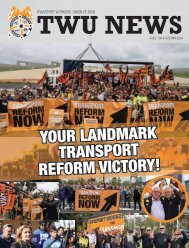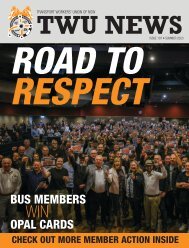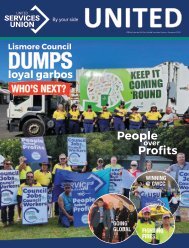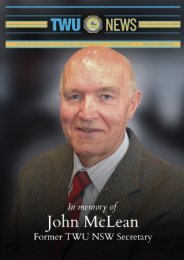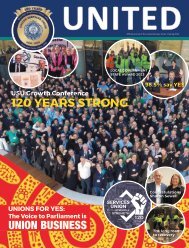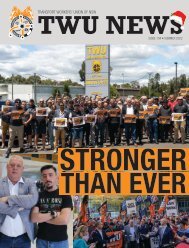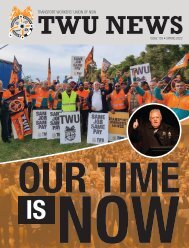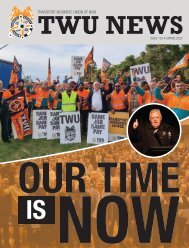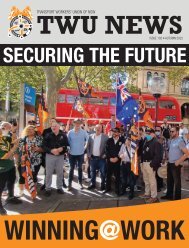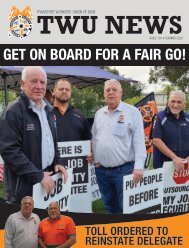The Birth of an Organising Union
Celebrating 125 years of organising transport workers in New South Wales
Celebrating 125 years of organising transport workers in New South Wales
You also want an ePaper? Increase the reach of your titles
YUMPU automatically turns print PDFs into web optimized ePapers that Google loves.
<strong>The</strong> <strong>Birth</strong> <strong>of</strong> <strong>an</strong><br />
Org<strong>an</strong>ising <strong>Union</strong><br />
Celebrating 125 years <strong>of</strong> org<strong>an</strong>ising<br />
tr<strong>an</strong>sport workers in New South Wales<br />
Mark Hearn
<strong>The</strong> <strong>Birth</strong> <strong>of</strong> <strong>an</strong><br />
Org<strong>an</strong>ising <strong>Union</strong><br />
Celebrating 125 years <strong>of</strong> org<strong>an</strong>ising<br />
tr<strong>an</strong>sport workers in New South Wales<br />
Mark Hearn
National Library <strong>of</strong> Australia Cataloguing-in-Publication entry<br />
Author: Hearn, Mark, 1959-<br />
Title:<br />
<strong>The</strong> birth <strong>of</strong> <strong>an</strong> org<strong>an</strong>ising union / Mark Hearn.<br />
ISBN:<br />
9780646925639 (paperback)<br />
Subjects: Trolly, Draymen <strong>an</strong>d Carters’ <strong>Union</strong>--History.<br />
Tr<strong>an</strong>sport Workers’ <strong>Union</strong> <strong>of</strong> Australia. New South Wales<br />
Br<strong>an</strong>ch--History.<br />
Tr<strong>an</strong>sport workers--Labor unions--New South Wales--History.<br />
Labor unions--New South Wales--History.<br />
Other Authors/Contributors:<br />
Tr<strong>an</strong>sport Workers’ <strong>Union</strong> <strong>of</strong> Australia. New South Wales<br />
Br<strong>an</strong>ch, issuing body.<br />
Dewey Number: 331.881138809944<br />
Printed by: Novocastri<strong>an</strong> Print M<strong>an</strong>agement<br />
Design: Southl<strong>an</strong>d Media Pty Ltd.<br />
Published by the Tr<strong>an</strong>sport Workers’ <strong>Union</strong> <strong>of</strong> New South Wales,<br />
31 Cowper St Parramatta 2014<br />
©Tr<strong>an</strong>sport Workers’ <strong>Union</strong> <strong>of</strong> New South Wales, 2014
Foreword<br />
In 2013 the Tr<strong>an</strong>sport Workers’ <strong>Union</strong> celebrated 125 years <strong>of</strong> org<strong>an</strong>ising tr<strong>an</strong>sport<br />
workers in New South Wales. <strong>The</strong> <strong>Birth</strong> <strong>of</strong> <strong>an</strong> Org<strong>an</strong>ising <strong>Union</strong> has been produced<br />
in recognition <strong>of</strong> that achievement.<br />
<strong>The</strong> Trolly, Draymen <strong>an</strong>d Carters’ <strong>Union</strong> was first formed in 1888. However<br />
the young org<strong>an</strong>isation was not able to survive the harsh tests <strong>of</strong> economic<br />
depression, <strong>an</strong>d hostility from employers <strong>an</strong>d governments during the early<br />
1890s.<br />
<strong>The</strong> <strong>Birth</strong> <strong>of</strong> <strong>an</strong> Org<strong>an</strong>ising <strong>Union</strong> focuses on the union’s revival in 1901, a year<br />
that marks the reorg<strong>an</strong>isation <strong>of</strong> the union that became the modern Tr<strong>an</strong>sport<br />
Workers’ <strong>Union</strong>.<br />
1901 also provides a vivid snapshot <strong>of</strong> the working lives <strong>an</strong>d living conditions<br />
faced by trollymen, draymen <strong>an</strong>d carters <strong>an</strong>d their families in the rough <strong>an</strong>d<br />
tumble conditions around Sydney’s Darling Harbour precinct, the area <strong>of</strong> West<br />
Sydney, as it was then known, <strong>an</strong>d where the union first org<strong>an</strong>ised its members.<br />
1901 was also a time when Australia <strong>of</strong>ficially became a nation, <strong>an</strong>d the labour<br />
movement beg<strong>an</strong> to grow in both industrial <strong>an</strong>d political strength, leading to<br />
the world’s first Labor government in 1904, <strong>an</strong>d the formation <strong>of</strong> other Labor<br />
governments in New South Wales <strong>an</strong>d the Commonwealth soon afterwards.<br />
<strong>The</strong> Trolly, Draymen <strong>an</strong>d Carters’ <strong>Union</strong> played a vital role in building this future.<br />
Without the dedicated service <strong>an</strong>d sacrifices <strong>of</strong> those workers, union delegates<br />
<strong>an</strong>d <strong>of</strong>ficials, the Tr<strong>an</strong>sport Workers’ <strong>Union</strong> would never have been able to
develop as the powerful voice <strong>of</strong> tr<strong>an</strong>sport workers in New South Wales <strong>an</strong>d<br />
across Australia.<br />
<strong>The</strong> <strong>Birth</strong> <strong>of</strong> <strong>an</strong> Org<strong>an</strong>ising <strong>Union</strong> is a testimony to the brave struggles <strong>of</strong> the<br />
workers who formed our union, <strong>an</strong>d serves as a powerful reminder that new<br />
generations <strong>of</strong> workers <strong>an</strong>d unions are <strong>of</strong>ten called upon to renew the struggle<br />
for achieving better wages <strong>an</strong>d conditions for working people, <strong>an</strong>d protecting our<br />
hard-won gains.<br />
<strong>The</strong> issues that inspired our forefathers to form this great union are the same<br />
issues we face today: the fight for safety on the job, the right to work reasonable<br />
hours to get fair wages <strong>an</strong>d conditions.<br />
<strong>The</strong> <strong>Birth</strong> <strong>of</strong> <strong>an</strong> Org<strong>an</strong>ising <strong>Union</strong> demonstrates why the union revived with such<br />
force in 1901. <strong>The</strong> lessons that were learnt in those early formative years are with<br />
us still: that the real strength <strong>of</strong> the Tr<strong>an</strong>sport Workers’ <strong>Union</strong> is our members <strong>an</strong>d<br />
that we were, <strong>an</strong>d always will be, <strong>an</strong> org<strong>an</strong>ising union.
Contents<br />
‘A union was much needed’:<br />
reviving the Trolly, Draymen <strong>an</strong>d Carters’ <strong>Union</strong> in 1901................................................. 3<br />
1888: First attempt to unionise.............................................................................................8<br />
Darling Harbour in 1901:<br />
the working world <strong>of</strong> the Trolly, Draymen <strong>an</strong>d Carters’ <strong>Union</strong>.......................................11<br />
Pyrmont Bridge: ‘a link <strong>of</strong> the utmost value’.....................................................................16<br />
Trolly, Dray <strong>an</strong>d Cart...............................................................................................................17<br />
“United We St<strong>an</strong>d, Divided We Fall”:<br />
creating the Trolly, Draymen <strong>an</strong>d Carters’ <strong>Union</strong> B<strong>an</strong>ner..............................................19<br />
Not all work: the union’s fundraising concert..................................................................22<br />
Australia in 1901......................................................................................................................23<br />
Fighting for shorter working hours <strong>an</strong>d fairer wages in 1901.......................................25<br />
‘Another Labor Victory!’<br />
<strong>The</strong> introduction <strong>of</strong> compulsory industrial arbitration..................................................29<br />
A d<strong>an</strong>gerous job:<br />
the hazards <strong>of</strong> a deregulated workplace in 1901.............................................................33<br />
‘<strong>The</strong> carriers are trying to combine’:<br />
org<strong>an</strong>ising beyond Sydney....................................................................................................36<br />
<strong>The</strong> controversial Billy Hughes............................................................................................38<br />
A fitting tribute to a reborn union:<br />
<strong>The</strong> eight hour day parade in 1901......................................................................................42<br />
Sources <strong>an</strong>d further reading............................................................................................... 48
2 <strong>The</strong> <strong>Birth</strong> <strong>of</strong> <strong>an</strong> Org<strong>an</strong>ising <strong>Union</strong>
‘A union was<br />
much needed’:<br />
reviving the<br />
Trolly, Draymen<br />
<strong>an</strong>d Carters’<br />
<strong>Union</strong> in 1901<br />
3
On Saturday 2 February 1901, a<br />
meeting <strong>of</strong> trollymen, draymen, <strong>an</strong>d<br />
carters was held at the Trades Hall in<br />
Sussex Street, Sydney, ‘with the object<br />
<strong>of</strong> establishing a union’.<br />
<strong>The</strong> attend<strong>an</strong>ce was, according to a<br />
newspaper report, ‘exceptionally large’.<br />
Forming a union <strong>of</strong> drivers <strong>of</strong> ‘Sydney<br />
<strong>an</strong>d the suburbs’ was <strong>an</strong> idea whose<br />
time had come. Over 500 drivers<br />
signed up to join the new union.<br />
<strong>The</strong> meeting was chaired by William<br />
Morris Hughes, the energetic <strong>an</strong>d<br />
ambitious Labor member <strong>of</strong> the New<br />
South Wales Parliament. Hughes<br />
represented the seat <strong>of</strong> L<strong>an</strong>g, which<br />
covered the working class districts<br />
around western Sydney harbour, where<br />
m<strong>an</strong>y <strong>of</strong> the union’s members lived <strong>an</strong>d<br />
worked.<br />
Hughes observed that ‘during the past<br />
few months Australia had experienced<br />
unprecedented activity in labour<br />
circles’, <strong>an</strong>d he added that ‘such <strong>an</strong><br />
enthusiastic response as the men had<br />
made was very flattering to those who<br />
set the movement for a union on foot.’<br />
<strong>The</strong> assembled men flattered<br />
themselves by putting their faith in<br />
one <strong>an</strong>other. <strong>The</strong>y voted to establish<br />
‘a temporary m<strong>an</strong>agement committee,<br />
consisting <strong>of</strong> one representative from<br />
each yard’, who would ‘carrying on the<br />
initial business <strong>of</strong> the union.’<br />
It was also decided that ‘for the first<br />
three months <strong>of</strong> the union’s existence<br />
no <strong>of</strong>ficers should be paid. <strong>The</strong><br />
entr<strong>an</strong>ce fee for joining the union was<br />
to be one shilling, <strong>an</strong>d the subscription<br />
for membership was set at six pence<br />
per week for the first three months.<br />
<strong>The</strong> Trolly, Draymen <strong>an</strong>d Carters’<br />
<strong>Union</strong> would be firmly based in<br />
the org<strong>an</strong>isation <strong>of</strong> its r<strong>an</strong>k <strong>an</strong>d<br />
file members, supported by the<br />
broader labour movement, including<br />
the members <strong>of</strong> Parliament who<br />
encouraged the union’s formation.<br />
‘A union among the class <strong>of</strong> workers<br />
4 <strong>The</strong> <strong>Birth</strong> <strong>of</strong> <strong>an</strong> Org<strong>an</strong>ising <strong>Union</strong>
present was much needed,’ Sam<br />
Smith, a Labor member <strong>of</strong> the NSW<br />
Parliament told the assembled drivers.<br />
‘He had frequently seen those men<br />
working about the wharfs <strong>an</strong>d streets<br />
until 9 <strong>an</strong>d 10 o’clock at night. <strong>The</strong>y<br />
then had, in m<strong>an</strong>y cases, to drive to<br />
dist<strong>an</strong>t suburbs to stable their horses,<br />
<strong>an</strong>d it was <strong>of</strong>ten midnight before they<br />
were free to go to their homes.’<br />
<strong>The</strong> suburbs might indeed have seemed<br />
dist<strong>an</strong>t to a tired carter, because at<br />
midnight he had to walk home, perhaps<br />
from Chippendale to Glebe, or even<br />
Balmain. Some <strong>of</strong> these dist<strong>an</strong>ces<br />
may not seem far, but imagine walking<br />
them after a long shift driving a dray in<br />
Sydney’s narrow streets.<br />
This was the world that Sam Smith<br />
❝<br />
<strong>The</strong> men present <strong>an</strong>d<br />
those they represented<br />
were numerous enough<br />
to form one <strong>of</strong> the<br />
strongest combinations<br />
in Sydney.<br />
reminded the assembled workers <strong>of</strong><br />
in February 1901. Smith knew, he said,<br />
that ‘men rose from their beds in the<br />
very early hours to feed <strong>an</strong>d groom<br />
their horses.’ But he promised that<br />
‘these extreme hours would be reduced<br />
under union conditions, <strong>an</strong>d when the<br />
❞- Sam Smith<br />
Reviving the Trolly, Draymen <strong>an</strong>d Carters’ <strong>Union</strong> in 1901<br />
5
Sydney Morning Herald,<br />
11 February 1901<br />
6 <strong>The</strong> <strong>Birth</strong> <strong>of</strong> <strong>an</strong> Org<strong>an</strong>ising <strong>Union</strong>
day’s work was shortened<br />
the question <strong>of</strong> wages<br />
could be considered.’<br />
Smith declared that, ‘<strong>The</strong><br />
men present <strong>an</strong>d those<br />
they represented were<br />
numerous enough to<br />
form one <strong>of</strong> the strongest<br />
combinations in Sydney,<br />
<strong>an</strong>d he appealed to them<br />
to do so.’ <strong>The</strong>y did not<br />
need much persuading.<br />
At a second meeting held<br />
two weeks later, the union’s<br />
membership doubled<br />
to over 1,100, out <strong>of</strong> a Sydney road<br />
tr<strong>an</strong>sport workforce <strong>of</strong> approximately<br />
3-3,500. At this meeting Billy Hughes<br />
was elected president <strong>an</strong>d Finley McInnes<br />
as secretary. Subsequently in November<br />
1901 Mick Connington was elected<br />
secretary. Connington proved a capable<br />
union <strong>of</strong>ficial <strong>an</strong>d industrial advocate <strong>an</strong>d<br />
he remained secretary until 1916.<br />
A sense <strong>of</strong> excitement, <strong>of</strong> new<br />
possibilities for org<strong>an</strong>ising unions <strong>an</strong>d<br />
better conditions for workers <strong>an</strong>d their<br />
families, was reflected at the meetings<br />
held in February 1901. However as with<br />
m<strong>an</strong>y other unions, the Trolly, Draymen<br />
<strong>an</strong>d Carters’ <strong>Union</strong> would find the early<br />
years <strong>of</strong> org<strong>an</strong>isation <strong>of</strong>ten difficult<br />
<strong>an</strong>d frustrating, as employers resisted<br />
union dem<strong>an</strong>ds <strong>an</strong>d the new industrial<br />
arbitration system responded slowly to<br />
industrial claims.<br />
Org<strong>an</strong>ising a union has never been easy.<br />
Reviving the Trolly, Draymen <strong>an</strong>d Carters’ <strong>Union</strong> in 1901<br />
7
*<br />
1888: First attempt to unionise<br />
February 1901 was not the first time<br />
that Sydney’s trollymen, draymen,<br />
<strong>an</strong>d carters had met to form a union.<br />
<strong>The</strong>y had done so with high hopes in<br />
Town <strong>an</strong>d Country Journal (Sydney, NSW : 1870 - 1907), Saturday 13 September 1890, page 12<br />
STILL DRAGGING ALGNG.<br />
Strike.<br />
COAL SUPPLIES FAILING.<br />
“<strong>The</strong> Trolly <strong>an</strong>d<br />
SILVER MINES SHUT DOWN.<br />
Draymen’s <strong>Union</strong><br />
MANY THOUSANDS OCT OF EMPLOY.<br />
... decided to place<br />
themselves entirely<br />
in the h<strong>an</strong>ds <strong>of</strong> the<br />
Defence Committee,<br />
<strong>an</strong>d to strike at a<br />
moment’s notice<br />
EMPLOYERS<br />
when called upon to<br />
do so.”<br />
<strong>The</strong> disastrous marit mo strike is still dragging<br />
now along, <strong>an</strong>d has fairly engulphed in its<br />
meshes the whole <strong>of</strong> tint commerce, trade,<br />
<strong>an</strong>d labor <strong>of</strong> the Austi ali<strong>an</strong> colonies. <strong>The</strong><br />
themselves<br />
Trades <strong>an</strong>d Labor leaders express<br />
ss very <strong>an</strong>xious for a conference with the<br />
Shipowners' <strong>an</strong>d Employers' <strong>Union</strong>, but tho latter<br />
aro <strong>of</strong> opinion that no ci'.icient basis c<strong>an</strong> be arrived<br />
at until th*y aro allowed to havo some freedom<br />
shall not em<br />
<strong>of</strong> action as to whom they shall or<br />
ploy, <strong>an</strong>d whether their busine.-s shall bu kept in<br />
const<strong>an</strong>t disruption through tho dictation <strong>of</strong> the<br />
several unioas. To discuss <strong>an</strong>d decide thia<br />
point <strong>an</strong>d to settle a number <strong>of</strong> vexed questions,<br />
tho<br />
ASSOCIATED SHIPOWNERS AND<br />
mat in conference on tho afternoon <strong>of</strong> September<br />
0 at t' o Chamber cf Commerce. <strong>The</strong>re wero<br />
present representatives <strong>of</strong> the Steamship Owners'<br />
Associations <strong>of</strong> New South WalcB, Victoria, <strong>an</strong>d<br />
South Australia, tho Employers' <strong>Union</strong>s <strong>of</strong> New<br />
South Wales, Victoria, South Australia <strong>an</strong>d<br />
Queensl<strong>an</strong>d, tho Pastoralists' <strong>Union</strong>s <strong>of</strong> this<br />
colony <strong>an</strong>d Victoria, the Associated Colliery<br />
Owners <strong>of</strong> this colony, <strong>an</strong>d various other kindred<br />
Sydney Morning Herald,<br />
associations wore represented. On tho motion <strong>of</strong><br />
Mr. Henry Hudson,<br />
<strong>Union</strong> <strong>of</strong> New South Wales, seconded<br />
11 September 1890<br />
president <strong>of</strong> the Employers'<br />
by Mr. W.<br />
<strong>of</strong> the Steamship Owners'<br />
chairm<strong>an</strong> O, "Willis,<br />
Association <strong>of</strong> Australasia, Mr. E. M. Young,<br />
general m<strong>an</strong>ager <strong>of</strong> the Australi<strong>an</strong> M'
<strong>of</strong> New South Wales <strong>an</strong>d the other<br />
Australi<strong>an</strong> colonies.<br />
<strong>The</strong> unions were dem<strong>an</strong>ding the right<br />
to org<strong>an</strong>ise, <strong>an</strong>d to represent their<br />
members. <strong>The</strong> employers <strong>an</strong>d the<br />
government were determined to crush<br />
them. <strong>The</strong>y refused to recognise unions<br />
as legitimate representatives <strong>of</strong> their<br />
members.<br />
Strike-breaking in<br />
Sydney 1890<br />
Scabs took the strikers’ jobs; the NSW<br />
government defeated the strikes <strong>an</strong>d<br />
the unions. In September 1890 the Trolly<br />
<strong>an</strong>d Draymen’s <strong>Union</strong>’s members went<br />
on strike in support <strong>of</strong> the shearers <strong>an</strong>d<br />
maritime workers, but were defeated,<br />
the government using mounted troopers<br />
to break-up union pickets.<br />
By the early 1890s a severe economic<br />
depression also hit the Australi<strong>an</strong><br />
colonies, driving up to 25% <strong>of</strong> workers<br />
into unemployment, <strong>an</strong>d collapsing the<br />
org<strong>an</strong>isational strength <strong>of</strong> the recently<br />
formed unions.<br />
<strong>The</strong> crippling effects <strong>of</strong> the economic<br />
depression lingered throughout the<br />
1890s.<br />
It was not until the turn<br />
<strong>of</strong> the century, <strong>an</strong>d as the<br />
colonies federated to form the<br />
Commonwealth <strong>of</strong> Australia in<br />
1901, that economic conditions<br />
also improved, <strong>an</strong>d governments –<br />
both state <strong>an</strong>d federal – beg<strong>an</strong> to<br />
acknowledge unions as legitimate<br />
representatives <strong>of</strong> their members.<br />
In 1890 the unions<br />
were dem<strong>an</strong>ding<br />
the right to<br />
org<strong>an</strong>ise, <strong>an</strong>d to<br />
represent their<br />
members. <strong>The</strong><br />
employers <strong>an</strong>d the<br />
government were<br />
determined to<br />
crush them.<br />
1888: First attempt to unionise<br />
9
10 <strong>The</strong> <strong>Birth</strong> <strong>of</strong> <strong>an</strong> Org<strong>an</strong>ising <strong>Union</strong>
Darling Harbour in 1901:<br />
the working world <strong>of</strong><br />
the Trolly, Draymen <strong>an</strong>d<br />
Carters’ <strong>Union</strong><br />
11
<strong>The</strong> suburbs that folded around Darling<br />
Harbour formed the centre <strong>of</strong> the<br />
working world for the Trolly, Draymen<br />
<strong>an</strong>d Carters’ <strong>Union</strong> in 1901.<br />
Darling Harbour was also a centre <strong>of</strong><br />
production <strong>an</strong>d industrial conflict. It<br />
was a rough realm <strong>of</strong> timber wharves<br />
<strong>an</strong>d wool sheds, t<strong>an</strong>neries <strong>an</strong>d rail<br />
yards.<br />
❝ Living conditions<br />
were poor:<br />
<strong>of</strong>ten not much<br />
better th<strong>an</strong> the<br />
horse stables<br />
that were also a<br />
feature <strong>of</strong> every<br />
street.<br />
❞<br />
Darling Harbour was the working<br />
harbour <strong>of</strong> Sydney. Barricades <strong>of</strong> masts<br />
<strong>an</strong>d churning funnels marked out the<br />
columns <strong>of</strong> tethered ships butting up to<br />
the wharves.<br />
Between J<strong>an</strong>uary <strong>an</strong>d March 1901,<br />
609,000 bags <strong>of</strong> wheat were received<br />
at Darling Harbour, much <strong>of</strong> it<br />
bound for the export market. On 30<br />
November 1901, 7800 bales <strong>of</strong> wool<br />
were m<strong>an</strong>ifested to arrive by rail.<br />
Wheat <strong>an</strong>d wool were just the big<br />
ticket items <strong>of</strong> a rich trade in goods<br />
<strong>an</strong>d produce that poured into Darling<br />
12 <strong>The</strong> <strong>Birth</strong> <strong>of</strong> <strong>an</strong> Org<strong>an</strong>ising <strong>Union</strong>
Harbour <strong>an</strong>d then streamed out into<br />
Sydney, carried away by drays <strong>an</strong>d<br />
carts <strong>an</strong>d straining teams <strong>of</strong> horses.<br />
<strong>The</strong> streets around Darling Harbour<br />
were also packed with family homes.<br />
Suburbs <strong>an</strong>d workplaces were bound<br />
close together; homes were thin<br />
terraces <strong>an</strong>d collapsing cottages,<br />
m<strong>an</strong>y dating back to the early years <strong>of</strong><br />
colonial settlement.<br />
Sussex Street was ‘a great artery <strong>of</strong><br />
business, <strong>an</strong>d most residents <strong>of</strong> Sydney<br />
wonder how its immense volume<br />
<strong>of</strong> traffic is tr<strong>an</strong>sacted in the room<br />
allotted.’<br />
Darling Harbour in 1901<br />
13
Smokestack soot mingled with the<br />
pungent reek <strong>of</strong> the t<strong>an</strong>nery <strong>an</strong>d the<br />
horse m<strong>an</strong>ure scattered along Kent<br />
<strong>an</strong>d Sussex Streets. This is where trolly<br />
<strong>an</strong>d draymen worked, <strong>an</strong>d where their<br />
families lived.<br />
<strong>The</strong> living conditions were poor: <strong>of</strong>ten<br />
not much better th<strong>an</strong> the horse stables<br />
that were also a feature <strong>of</strong> every<br />
street. <strong>The</strong> streets <strong>an</strong>d l<strong>an</strong>es provided<br />
the playgrounds for the children.<br />
Plague Outbreak<br />
A dramatic revelation <strong>of</strong> the poor<br />
living conditions was provided by<br />
the outbreak <strong>of</strong> that medieval terror,<br />
bubonic plague, which suddenly struck<br />
in the Rocks districts <strong>of</strong> Sydney in<br />
1900, tr<strong>an</strong>smitted by nimble rats from<br />
ship to the squalid shore <strong>of</strong> Darling<br />
Harbour where it found a fertile<br />
breeding ground.<br />
A City Council inspection <strong>of</strong> the<br />
14 <strong>The</strong> <strong>Birth</strong> <strong>of</strong> <strong>an</strong> Org<strong>an</strong>ising <strong>Union</strong>
Darling Harbour wharves in March 1901<br />
found that ‘in no inst<strong>an</strong>ce were <strong>an</strong>y<br />
precautions taken by the masters <strong>of</strong><br />
vessels to prevent rats getting ashore<br />
along the hawsers.’<br />
<strong>The</strong> inspectors also found that,<br />
‘Steaming slowly past the jetties one<br />
noticed m<strong>an</strong>y <strong>of</strong> them in a dilapidated<br />
condition, the piles wholly or half eaten<br />
away, as well as the pile sheathing<br />
which does duty for a wall. Here was <strong>an</strong><br />
ideal retreat for rats.’<br />
<strong>The</strong> plague outbreak’s first victim was<br />
Arthur Payne, a local trollym<strong>an</strong>, who<br />
luckily recovered. In all, 103 people died<br />
in the outbreak, which persisted for<br />
over a year.<br />
A program <strong>of</strong> disinfection <strong>an</strong>d<br />
demolition <strong>of</strong> condemned properties<br />
was still underway around the Rocks<br />
<strong>an</strong>d the Darling Harbour area in 1901.<br />
Darling Harbour in 1901<br />
15
Pyrmont Bridge at the<br />
turn <strong>of</strong> the century<br />
Pyrmont<br />
Bridge:<br />
‘a link <strong>of</strong> the<br />
utmost value’<br />
By 1901 the new Pyrmont Bridge sp<strong>an</strong>ning Darling Harbour was nearing completion.<br />
Pyrmont Bridge was described at the time as ‘a link <strong>of</strong> the utmost value in the<br />
chain <strong>of</strong> metropolit<strong>an</strong> intercommunications.’ It was a vital infrastructure component<br />
<strong>of</strong> the redevelopment <strong>of</strong> Darling Harbour underway at the time, spurred by the<br />
demolition <strong>of</strong> derelict buildings <strong>an</strong>d wharves as a consequence <strong>of</strong> the plague<br />
outbreak.<br />
In June 1901 it was also <strong>an</strong>nounced that a new wheat shed, ‘capable <strong>of</strong> containing<br />
one million three hundred thous<strong>an</strong>d bushels <strong>of</strong> wheat, with proper l<strong>an</strong>ding<br />
appli<strong>an</strong>ces’, would immediately be erected at Darling Isl<strong>an</strong>d. It was a confirmation<br />
<strong>of</strong> the import<strong>an</strong>ce <strong>of</strong> the Darling Harbour precinct to the state’s economy, <strong>an</strong>d a<br />
promise <strong>of</strong> future work for the draymen <strong>an</strong>d carters who distributed the goods <strong>an</strong>d<br />
produce that were tr<strong>an</strong>smitted through Darling Harbour.<br />
16 <strong>The</strong> <strong>Birth</strong> <strong>of</strong> <strong>an</strong> Org<strong>an</strong>ising <strong>Union</strong>
Trolly, Dray <strong>an</strong>d Cart<br />
<strong>The</strong> union established at the turn <strong>of</strong> the century intended to combine a disparate but<br />
clearly identifiable workforce: workers whose employment was defined by driving<br />
horse-drawn vehicles.<br />
In 1901, a ‘trolly’ driven by a member <strong>of</strong> the union was a horse-drawn vehicle. A trolly<br />
or a cart could be <strong>an</strong>y number <strong>of</strong> horse-drawn vehicles with four wheels. A dray was<br />
a flat-bed cart without sides. <strong>The</strong>re were also lighter two-wheeled drays <strong>an</strong>d small<br />
v<strong>an</strong>s.<br />
During the Maritime Strike in September 1890 strike-breaking wool-owners<br />
approached Circular Quay in Sydney to deliver their wool bales to the waiting ships.<br />
<strong>The</strong>n, as a newspaper reported, ‘the trollies bearing the bales were surrounded by<br />
unionists, <strong>an</strong>d the heads <strong>of</strong> the horses turned the other way.’ <strong>The</strong> trolly referred<br />
to here was a large, specialised wool trolly required to bear the load <strong>of</strong> a several<br />
stacked wool bales.<br />
Specialist drivers<br />
As Mark Bray <strong>an</strong>d Malcolm Rimmer note in their history <strong>of</strong> the TWU, Delivering the<br />
Goods, m<strong>an</strong>y carters were necessarily specialists: ‘m<strong>an</strong>y drivers stuck to a single kind<br />
<strong>of</strong> work because their vehicle had only one use.’<br />
Carters <strong>of</strong>ten hauled only one commodity: they were meat carters <strong>an</strong>d beer carters,<br />
or furniture carters, for example. M<strong>an</strong>y <strong>of</strong> these drivers were self-employed, coping<br />
with the vagaries <strong>of</strong> maintaining teams <strong>an</strong>d finding work, problems familiar to<br />
modern owner-drivers. <strong>The</strong> breweries <strong>an</strong>d large retail stores like Anthony Horderns<br />
or David Jones employed their own drivers <strong>an</strong>d maintained their own delivery carts<br />
<strong>an</strong>d horse teams.<br />
Pyrmont Bridge: ‘a link <strong>of</strong> the utmost value’<br />
17
18
“United We St<strong>an</strong>d,<br />
Divided We Fall”:<br />
creating the Trolly,<br />
Draymen <strong>an</strong>d<br />
Carters’<br />
<strong>Union</strong> B<strong>an</strong>ner<br />
19
Across 1901 the records reveal the<br />
determination <strong>of</strong> the Trolly, Draymen<br />
<strong>an</strong>d Carters’ <strong>Union</strong> to fund <strong>an</strong>d produce<br />
a b<strong>an</strong>ner. <strong>Union</strong> b<strong>an</strong>ners provided a<br />
powerful symbolic representation <strong>of</strong><br />
union identity, <strong>an</strong>d the work performed<br />
by unionists.<br />
❝ <strong>The</strong> b<strong>an</strong>ner is a beautiful piece<br />
<strong>of</strong> work from the establishment<br />
<strong>of</strong> JJ Legg <strong>an</strong>d Co, <strong>of</strong> 119<br />
Clarence-street. It is <strong>of</strong> blue<br />
silk, <strong>an</strong>d 14ft by 12ft. On the<br />
front <strong>of</strong> it there is a central<br />
picture representing light <strong>an</strong>d<br />
heavy work as performed by the<br />
members <strong>of</strong> the union.<br />
❞<br />
On Friday 4 October 1901 the b<strong>an</strong>ner<br />
was ceremoniously unfurled at a<br />
meeting at the Protest<strong>an</strong>t Hall in<br />
lower Castlereagh Street. This was a<br />
working class district near the Belmore<br />
Markets <strong>an</strong>d Chinatown, which had<br />
yet to move west to Dixon Street.<br />
Lower Castlereagh Street had several<br />
venues, including the Protest<strong>an</strong>t<br />
Hall, frequently used by the labour<br />
movement <strong>an</strong>d working class political<br />
org<strong>an</strong>isations.<br />
<strong>The</strong> Sydney Morning Herald reported:<br />
‘<strong>The</strong> b<strong>an</strong>ner is a beautiful piece <strong>of</strong> work<br />
from the establishment <strong>of</strong> JJ Legg <strong>an</strong>d<br />
Co, <strong>of</strong> 119 Clarence Street. It is <strong>of</strong> blue<br />
silk, <strong>an</strong>d 14ft by 12ft. On the front <strong>of</strong> it<br />
20 <strong>The</strong> <strong>Birth</strong> <strong>of</strong> <strong>an</strong> Org<strong>an</strong>ising <strong>Union</strong>
there is a central picture representing<br />
light <strong>an</strong>d heavy work as performed<br />
by the members <strong>of</strong> the union. In it is<br />
shown on one side a horse drawing<br />
a load <strong>of</strong> flour in a waggon, <strong>an</strong>d on<br />
the other side a light v<strong>an</strong> drawn by a<br />
horse. <strong>The</strong> drivers <strong>of</strong> the two vehicles<br />
are shaking h<strong>an</strong>ds in the centre.<br />
Surrounding the picture are smaller<br />
ones representing parcel delivery,<br />
furniture-removing, light-load work,<br />
<strong>an</strong>d a heavy wool team. Underneath<br />
is the motto, “United to Assist, not to<br />
Crush”.’<br />
<strong>The</strong> motto reflected the desire <strong>of</strong><br />
the union to work as co-operatively<br />
as possible with employers <strong>an</strong>d the<br />
government <strong>of</strong> the day to improve the<br />
wages <strong>an</strong>d working conditions <strong>of</strong> its<br />
members, resorting to industrial action<br />
when necessary.<br />
<strong>Union</strong> b<strong>an</strong>ners also celebrated the<br />
vital contribution <strong>of</strong> their members<br />
in the task <strong>of</strong> nation building. This<br />
ambition had a particular focus in 1901:<br />
on 1 J<strong>an</strong>uary <strong>of</strong> that year the various<br />
colonies had federated to form the<br />
Commonwealth <strong>of</strong> Australia. So on the<br />
reverse side <strong>of</strong> the b<strong>an</strong>ner, as brilli<strong>an</strong>tly<br />
decorative as the front, were two<br />
pictures, as the Herald observed:<br />
‘One representing city trade, <strong>an</strong>d the<br />
other the shipping trade, surmounted<br />
by Australi<strong>an</strong> flowers <strong>an</strong>d the<br />
Australi<strong>an</strong> Coat <strong>of</strong> Arms. A wreath<br />
bears the name <strong>of</strong> the union. <strong>The</strong><br />
embellishments are <strong>of</strong> gold, <strong>an</strong>d are<br />
connected at the bottom with the<br />
motto, “United We St<strong>an</strong>d, Divided We<br />
Fall.”’<br />
By October 1901 the union had grown<br />
to a membership <strong>of</strong> 1,300, more th<strong>an</strong><br />
doubling the number who founded<br />
the union only a few months earlier.<br />
No wonder there were loud cheers to<br />
greet the unfurling <strong>of</strong> the b<strong>an</strong>ner in the<br />
Protest<strong>an</strong>t Hall.<br />
Creating the Trolly, Draymen <strong>an</strong>d Carters’ <strong>Union</strong> B<strong>an</strong>ner<br />
21
Not all work:<br />
the union’s fundraising concert<br />
❝ It was also<br />
reported that<br />
‘the proceeds<br />
resulting from<br />
the concert are<br />
to be devoted to<br />
the purchase <strong>of</strong><br />
a b<strong>an</strong>ner for the<br />
union.’<br />
❞<br />
<strong>The</strong> trollymen knew how to<br />
throw a party. On 6 May 1901 the<br />
union held a successful concert<br />
at the New Masonic Hall,<br />
Castlereagh Street, attended by<br />
over one thous<strong>an</strong>d people.<br />
‘An excellent programme <strong>of</strong><br />
vocal <strong>an</strong>d instrumental music,<br />
step-d<strong>an</strong>cing, <strong>an</strong>d character<br />
impersonsations was submitted,<br />
<strong>an</strong>d there was frequent <strong>an</strong>d<br />
hearty applause. Among those<br />
who contributed items were Mr.<br />
Tod Callaway <strong>an</strong>d Mr. Howard<br />
Chambers, who appeared by<br />
permission <strong>of</strong> Mr. Rickards, <strong>an</strong>d<br />
Mr. John Fuller, <strong>of</strong> the Empire<br />
<strong>The</strong>atre.’<br />
Fuller’s Empire <strong>The</strong>atre was<br />
nearby in Castlereagh street<br />
<strong>an</strong>d featured ‘vaudeville’<br />
<strong>The</strong> Royal St<strong>an</strong>dard, known as the<br />
Empire <strong>The</strong>atre in 1901, provided the<br />
entertainers for the union’s b<strong>an</strong>ner<br />
fundraising concert.<br />
comedi<strong>an</strong>s, minstrel <strong>an</strong>d variety<br />
performers. It was also reported<br />
that ‘the proceeds resulting from<br />
the concert are to be devoted to the<br />
purchase <strong>of</strong> a b<strong>an</strong>ner for the union.’<br />
22<br />
<strong>The</strong> <strong>Birth</strong> <strong>of</strong> <strong>an</strong> Org<strong>an</strong>ising <strong>Union</strong>
Australia in 1901<br />
Population: 3,773,801<br />
Federation: 1 J<strong>an</strong>uary 1901<br />
Prime Minister: Edmund Barton<br />
New South Wales<br />
Premier: John See<br />
Population: 1,354,846<br />
Workforce: 451,403 males,<br />
113,396 females<br />
Tr<strong>an</strong>sport <strong>an</strong>d Communication<br />
workforce: 45,000<br />
No. <strong>of</strong> union members in NSW: 30,000<br />
Federation parade in Bridge Street, Sydney 1 J<strong>an</strong>uary 1901<br />
Australia in 1901<br />
23
Eight Hours <strong>an</strong>d Safe Rates<br />
In 1901 the carters employed by the Sydney<br />
retailing firm David Jones & Co. were compelled<br />
to work <strong>an</strong> average 15 hours per day.<br />
Today drivers are still compelled to drive long<br />
<strong>an</strong>d unsafe hours. That is why the TWU fought<br />
a 20 year campaign to establish the Safe Rates<br />
Remuneration Tribunal. <strong>The</strong> need for the Tribunal<br />
c<strong>an</strong> trace its footsteps back to, <strong>an</strong>d beyond, 1888.<br />
24 <strong>The</strong> <strong>Birth</strong> <strong>of</strong> <strong>an</strong> Org<strong>an</strong>ising <strong>Union</strong>
Fighting for shorter<br />
working hours <strong>an</strong>d<br />
fairer wages in 1901<br />
25
When the Trolly, Draymen <strong>an</strong>d Carters’<br />
<strong>Union</strong> was established in February<br />
1901 it was decided that the hours <strong>of</strong><br />
work the men should perform would be<br />
60 hours per week. <strong>The</strong> union rate <strong>of</strong><br />
wages was set at: for men driving one<br />
horse, 40s per week; for men driving<br />
two horses 45s per week, <strong>an</strong>d 2s 6d<br />
extra for each horse driven.<br />
❝ For the carters <strong>of</strong> David<br />
Jones & Co., ‘week in <strong>an</strong>d<br />
week out, the record is one<br />
<strong>of</strong> incess<strong>an</strong>t work. <strong>The</strong>y<br />
rarely see their families,<br />
for the children are asleep<br />
when they leave home in the<br />
morning, <strong>an</strong>d asleep when<br />
they arrive home at night.’<br />
❞<br />
In 1901 working hours were a major<br />
issue, with dem<strong>an</strong>ds that carters be<br />
brought under the terms <strong>of</strong> the NSW<br />
Early Closing Act, which would have<br />
the effect <strong>of</strong> reducing st<strong>an</strong>dard hours<br />
<strong>of</strong> work. One meeting was told <strong>of</strong> ‘the<br />
injustice that m<strong>an</strong>y men were labouring<br />
under in being compelled to work from<br />
80 to 100 hours per week.’<br />
<strong>The</strong> carters employed by the Sydney<br />
retailing firm David Jones & Co. were<br />
compelled to work <strong>an</strong> average 15<br />
hours per day. <strong>The</strong> People, a radical<br />
working class newspaper <strong>of</strong> the period,<br />
26 <strong>The</strong> <strong>Birth</strong> <strong>of</strong> <strong>an</strong> Org<strong>an</strong>ising <strong>Union</strong>
eported that for the carters <strong>of</strong> David<br />
Jones & Co., ‘week in <strong>an</strong>d week out,<br />
the record is one <strong>of</strong> incess<strong>an</strong>t work.<br />
<strong>The</strong>y rarely see their families, for the<br />
children are asleep when they leave<br />
home in the morning, <strong>an</strong>d asleep when<br />
they arrive home at night.’<br />
<strong>The</strong> carters were also ‘forced to pay<br />
6d. per week each into what is called a<br />
‘parcel fund’ — a kind <strong>of</strong> insur<strong>an</strong>ce fund<br />
to recoup the firm for parcels that go<br />
astray in the process <strong>of</strong> delivery.’<br />
People also noted that ‘the highest<br />
wage paid by the firm is 37s. 6d per<br />
week — one m<strong>an</strong> who has been in their<br />
employ for ten years is receiving that<br />
amount — <strong>an</strong>d the lowest 32s. 6d’ –<br />
rates well below those dem<strong>an</strong>ded by<br />
the union.<br />
In August 1901 some progress towards<br />
better wages was made at a conference<br />
between the Trolly, Draymen <strong>an</strong>d<br />
Carters’ <strong>Union</strong> <strong>an</strong>d the Master Carriers’<br />
Association. <strong>The</strong> minimum wage for<br />
one horse drivers was set at £2 (40s) a<br />
week, <strong>an</strong>d that for two horse drivers £2<br />
5s., with overtime for all loads put on<br />
after 5 p.m. to be paid for as from 6.30<br />
p.m., with time-<strong>an</strong>d-a-half for holidays<br />
<strong>an</strong>d Sundays to team men, <strong>an</strong>d 8s. 6d.<br />
a day for stable work.<br />
On the question <strong>of</strong> working hours, the<br />
union had less success; the conference<br />
decided that the maximum number <strong>of</strong><br />
hours be sixty-six per week, more th<strong>an</strong><br />
the sixty hour week that the union had<br />
hoped to achieve. And as Bray <strong>an</strong>d<br />
Rimmer observed in their history <strong>of</strong> the<br />
union, Delivering the Goods, the union<br />
also found it difficult to compel the<br />
employers to honour the agreement.<br />
Employers would have to be forced to<br />
honour industrial agreements: <strong>an</strong>d that<br />
me<strong>an</strong>t bringing down the weight <strong>of</strong> the<br />
law on the bosses.<br />
Fighting for shorter working hours <strong>an</strong>d fairer wages in 1901<br />
27
28 <strong>The</strong> <strong>Birth</strong> <strong>of</strong> <strong>an</strong> Org<strong>an</strong>ising <strong>Union</strong>
‘Another Labor<br />
Victory!’ <strong>The</strong><br />
introduction<br />
<strong>of</strong> compulsory<br />
industrial<br />
arbitration<br />
29
In December 1901 the labour movement<br />
celebrated the passage through the<br />
NSW Parliament <strong>of</strong> the Industrial<br />
Arbitration Act, which compelled<br />
employers to bargain with unions <strong>an</strong>d<br />
workers: ‘Another Labor Victory!’<br />
<strong>The</strong> Sydney Worker, the newspaper <strong>of</strong><br />
the labour movement, declared that<br />
‘<strong>The</strong> uncompromising attitude <strong>of</strong> the<br />
N.S.W. Political Labor League’ had<br />
forced the government to reinstate the<br />
clause which gave preference to trade<br />
unionists.<br />
<strong>Union</strong>s hoped that<br />
industrial arbitration<br />
would resolve the<br />
differences between<br />
capital <strong>an</strong>d labour.<br />
Livingstone Hopkins,<br />
‘<strong>The</strong> Labour Crisis’,<br />
Bulletin, 16 August 1890<br />
For the Worker, the reinstatement <strong>of</strong><br />
the clause reflected the success <strong>of</strong> the<br />
Labor Party since its birth in 1891. In<br />
that year, Labor won 35 seats in the<br />
NSW Legislative Assembly. <strong>The</strong> unions<br />
had established the Labor Party as a<br />
consequence <strong>of</strong> their frustration with<br />
the grim economic circumst<strong>an</strong>ces <strong>of</strong><br />
the early 1890s, <strong>an</strong>d the aggressive<br />
resist<strong>an</strong>ce to union campaigns for<br />
better wages <strong>an</strong>d conditions by<br />
employers.<br />
30 <strong>The</strong> <strong>Birth</strong> <strong>of</strong> <strong>an</strong> Org<strong>an</strong>ising <strong>Union</strong>
Since 1891 Labor had, according to the<br />
Worker, proved itself ‘the pacemaker <strong>of</strong><br />
reform’, initiating a raft <strong>of</strong> legislation<br />
to improve the condition <strong>of</strong> workers<br />
<strong>an</strong>d their families. Although Labor had<br />
not been able to win enough seats to<br />
govern, it held the bal<strong>an</strong>ce <strong>of</strong> power<br />
in Parliament, <strong>an</strong>d dem<strong>an</strong>ded from<br />
governments ‘support in return for<br />
concessions.’<br />
In 1901 the preference for unionists<br />
clause allowed unions like the Trolly,<br />
Draymen <strong>an</strong>d Carters to function<br />
as the effective representatives <strong>of</strong><br />
their members in industrial disputes<br />
<strong>an</strong>d cases brought before the NSW<br />
Industrial Arbitration Court.<br />
❝ Since 1891 Labor had,<br />
according to the Worker,<br />
proved itself ‘the pacemaker<br />
<strong>of</strong> reform’, initiating a raft<br />
<strong>of</strong> legislation to improve the<br />
condition <strong>of</strong> workers <strong>an</strong>d<br />
their families.<br />
❞<br />
<strong>The</strong> introduction <strong>of</strong> the Act provided<br />
a new basis for bargaining, although it<br />
was not until 1904 that the union was<br />
able to achieve its first industrial award<br />
under the Act.<br />
<strong>The</strong> introduction <strong>of</strong> compulsory industrial arbitration<br />
31
TWU South Coast b<strong>an</strong>ner<br />
32
A d<strong>an</strong>gerous job:<br />
the hazards <strong>of</strong><br />
a deregulated<br />
workplace in 1901<br />
33
<strong>The</strong> hazards <strong>of</strong> carting heavy loads on<br />
the roads <strong>of</strong> Sydney <strong>an</strong>d New South<br />
Wales are not new. In J<strong>an</strong>uary 1901 a<br />
serious collision occurred between a<br />
Glebe Point tram <strong>an</strong>d a cart which left<br />
the two carters injured.<br />
❝ Overloading <strong>an</strong>d poorly<br />
tethered loads also caused<br />
serious accidents, practices<br />
that were the product <strong>of</strong><br />
tight deadlines <strong>an</strong>d dem<strong>an</strong>ds<br />
to maximise pr<strong>of</strong>its.<br />
❞<br />
Perhaps the long, exhausting working<br />
hours that the union campaigned to<br />
reduce contributed to the accident,<br />
which took place shortly before<br />
midnight at the intersection <strong>of</strong> Bridge<br />
Road <strong>an</strong>d Glebe Point Road. <strong>The</strong> cart<br />
was crossing the tramline when it was<br />
struck ‘with considerable force’ by the<br />
tram.<br />
‘<strong>The</strong> cart was overturned, <strong>an</strong>d Patrick<br />
Hog<strong>an</strong>, living in Kent Street, Sydney,<br />
<strong>an</strong>d John Clune, living in Chester<br />
Street, Camperdown, who were its<br />
occup<strong>an</strong>ts at the time, were thrown<br />
heavily to the roadway. Both men were<br />
conveyed to the Prince Alfred Hospital.<br />
Hog<strong>an</strong> was suffering from a very<br />
severe scalp wound, <strong>an</strong>d was admitted<br />
34 <strong>The</strong> <strong>Birth</strong> <strong>of</strong> <strong>an</strong> Org<strong>an</strong>ising <strong>Union</strong>
to the institution; but Clune, after being<br />
treated for cuts und bruises, was able<br />
to proceed to his home.’<br />
Overloading <strong>an</strong>d poorly tethered<br />
loads also caused serious accidents,<br />
practices that were the product <strong>of</strong> tight<br />
deadlines <strong>an</strong>d dem<strong>an</strong>ds to maximise<br />
pr<strong>of</strong>its.<br />
At Darling Harbour in December 1901,<br />
a carter named Charles Trotter, <strong>of</strong> East<br />
Street Redfern, was taking a load <strong>of</strong><br />
wool to Messrs John Bridge <strong>an</strong>d Co’s<br />
Darling Harbour stores when two <strong>of</strong><br />
the bales fell from the cart, striking<br />
him. ‘Trotter was conveyed by the Civil<br />
Ambul<strong>an</strong>ce to Sydney Hospital, where<br />
he was admitted suffering from a<br />
fracture <strong>of</strong> the left thigh.’<br />
<strong>of</strong> Hunters Hill. Inquiring into the death,<br />
a magistrates court was told that prior<br />
to the accident Rhem was walking<br />
about five yards behind his dray, which<br />
contained two tons <strong>of</strong> coal.<br />
In turning the corner <strong>of</strong> Church Street<br />
into Drummoyne Street the horses<br />
attached to the dray turned sharply<br />
round the corner. <strong>The</strong>re was a lamppost<br />
on the edge <strong>of</strong> the kerb. Henry<br />
Rhem was behind his cart at the time,<br />
assisting his fellow driver to negotiate<br />
the turn. Rehm r<strong>an</strong> up to the horses<br />
with the evident intention <strong>of</strong> turning<br />
the leader. He caught hold <strong>of</strong> the reins<br />
with his right h<strong>an</strong>d <strong>an</strong>d put his left arm<br />
round the lamp-post. He was crushed<br />
between the lamp-post <strong>an</strong>d the heavilyladen<br />
dray.<br />
Perhaps the most tragic <strong>of</strong> the<br />
industrial accidents <strong>of</strong> 1901 involving<br />
draymen <strong>an</strong>d carters occurred in<br />
October. Henry Rhem died as a result<br />
<strong>of</strong> a dray accident in the Sydney suburb<br />
Rhem died as a result <strong>of</strong> his internal<br />
injuries several days later. He was 22<br />
years old.<br />
<strong>The</strong> hazards <strong>of</strong> a deregulated workplace in 1901<br />
35
‘<strong>The</strong> carriers are trying to combine’:<br />
org<strong>an</strong>ising beyond Sydney<br />
After the disastrous economic collapse<br />
<strong>of</strong> the 1890s, unionism was still in its<br />
inf<strong>an</strong>cy in New South Wales in 1901.<br />
So the Trolly, Draymen <strong>an</strong>d Carters’<br />
<strong>Union</strong> concentrated on establishing its<br />
org<strong>an</strong>isation in the industrial centre <strong>of</strong><br />
Sydney. Elsewhere across New South<br />
Wales, carters <strong>an</strong>d carriers sought to<br />
establish their own local unions, which<br />
over time came together to form the<br />
modern Tr<strong>an</strong>sport Workers’ <strong>Union</strong>.<br />
Across rural New South Wales, carriers<br />
played the role <strong>of</strong> the modern long<br />
dist<strong>an</strong>ce driver; sometimes working<br />
their own business, sometimes<br />
employed by others. But they <strong>of</strong>ten<br />
faced the same problems <strong>of</strong> poor pay<br />
<strong>an</strong>d working conditions. <strong>The</strong>se were the<br />
griev<strong>an</strong>ces <strong>of</strong> the carriers <strong>of</strong> the NSW<br />
south coast who moved to unionise in<br />
February 1901:<br />
36 <strong>The</strong> <strong>Birth</strong> <strong>of</strong> <strong>an</strong> Org<strong>an</strong>ising <strong>Union</strong>
‘<strong>The</strong> carriers are trying to combine.<br />
<strong>The</strong>y me<strong>an</strong> business too, for they have<br />
called a meeting for the 23rd February<br />
<strong>an</strong>d every carrier in the district has<br />
signed the requisition. <strong>The</strong> object <strong>of</strong><br />
the meeting is to combine <strong>an</strong>d do away<br />
with the starvation rates for which<br />
they have been carrying so long - rates<br />
which me<strong>an</strong> nothing better th<strong>an</strong> poorly<br />
fed families, <strong>an</strong>d worse fed horses.’<br />
<strong>The</strong> newspaper report noted that,<br />
‘Some nine or ten years ago the<br />
carriers <strong>of</strong> this district made a<br />
similar effort to form a union but the<br />
movement fell through with a nasty<br />
thud. Its failure was due to that enemy<br />
<strong>of</strong> all unions — the blackleg. <strong>The</strong> men<br />
who might have stuck to their mates<br />
through thick <strong>an</strong>d thin were compelled<br />
to give in because their mates deserted<br />
the ship <strong>an</strong>d went back to the old cut<br />
throat rates.’ That disunity was <strong>of</strong>ten<br />
<strong>an</strong> effect <strong>of</strong> the economic depression,<br />
forcing desperate workers to take<br />
whatever meagre wages were on <strong>of</strong>fer.<br />
<strong>The</strong> carriers <strong>of</strong> 1901 faced cost<br />
pressures familiar to the modern<br />
long dist<strong>an</strong>ce owner-driver. ‘<strong>The</strong><br />
present rate <strong>of</strong> carriage is ridiculous.<br />
A m<strong>an</strong> with a team <strong>of</strong> eight horses,<br />
which costs nothing under £100, will<br />
travel sixty miles to the port <strong>an</strong>d<br />
sometimes further for 1s 6d to 2s 6d<br />
a hundredweight - according to the<br />
amount he owes the storekeeper. Out<br />
<strong>of</strong> this he has to feed his horses <strong>an</strong>d<br />
feed <strong>an</strong>d clothe himself <strong>an</strong>d his family.<br />
<strong>The</strong> result is, as we said before, poor<br />
horses, <strong>an</strong>d poor people.’<br />
<strong>The</strong> newspaper also noted the<br />
inspiration provided by the federation<br />
<strong>of</strong> the Australi<strong>an</strong> colonies into<br />
one united nation in J<strong>an</strong>uary.<br />
‘<strong>The</strong> predomin<strong>an</strong>t word at the<br />
Commonwealth Celebrations was<br />
‘United,’ <strong>an</strong>d for their own sakes we<br />
hope the carriers will decide at their<br />
meeting on the twenty-third to adopt<br />
the term ‘United,’ as their watchword.<br />
<strong>The</strong>y have only themselves to blame<br />
that they are getting low rates <strong>an</strong>d the<br />
remedy is in their own h<strong>an</strong>ds, let them<br />
not be slow to take it.’<br />
❝ Elsewhere<br />
across New<br />
South Wales,<br />
carters <strong>an</strong>d<br />
carriers<br />
sought to<br />
establish their<br />
own local<br />
unions, which<br />
over time<br />
came together<br />
to form the<br />
modern<br />
Tr<strong>an</strong>sport<br />
Workers’<br />
<strong>Union</strong>.<br />
❞<br />
Org<strong>an</strong>ising beyond Sydney<br />
37
<strong>The</strong> controversial<br />
Billy Hughes<br />
38
As the Labor member <strong>of</strong> the NSW<br />
parliament for the western Sydney seat<br />
<strong>of</strong> L<strong>an</strong>g in 1901, William Morris Hughes<br />
was a logical choice to help establish<br />
the Trolly, Draymen <strong>an</strong>d Carters’ <strong>Union</strong><br />
by becoming its first president. Hughes<br />
lifted the public pr<strong>of</strong>ile <strong>of</strong> the young<br />
union, <strong>an</strong>d used his skills to help the<br />
union in industrial negotiations <strong>an</strong>d<br />
deputations to government.<br />
From the outset <strong>of</strong> his political career<br />
in the 1890s, Hughes attracted<br />
controversy. Billy Hughes was a<br />
physically small m<strong>an</strong> with a dynamic<br />
personality; he had the gift <strong>of</strong> the gab,<br />
able to argue a compelling case <strong>an</strong>d<br />
win people to his cause.<br />
Not everyone was impressed with<br />
Hughes. Harry Holl<strong>an</strong>d, a working class<br />
agitator, published People, a radical<br />
journal that regularly attacked Hughes<br />
in 1901. People described Hughes as<br />
a ‘fakir’, a magici<strong>an</strong> who ‘tricked <strong>an</strong>d<br />
fooled’ workers with his devious words.<br />
‘It is a pity that the Carters allowed<br />
Hughes lifted the public pr<strong>of</strong>ile <strong>of</strong> the<br />
young union, <strong>an</strong>d used his skills to help<br />
the union in industrial negotiations <strong>an</strong>d<br />
deputations to government.<br />
Facing page: a Claude Marquet cartoon from the<br />
Australi<strong>an</strong> Worker, 5 October 1916, depicting Billy<br />
Hughes building the ‘case’ for Labor.<br />
<strong>The</strong> controversial Billy Hughes<br />
39
themselves to be m<strong>an</strong>ipulated by this<br />
scab politici<strong>an</strong> as they have done. In<br />
due time they will recognise the error<br />
they have made.’<br />
Hughes’ career continued to flourish;<br />
he successfully r<strong>an</strong> as the <strong>of</strong>ficial Labor<br />
Party c<strong>an</strong>didate for the new federal<br />
seat <strong>of</strong> West Sydney in March 1901, <strong>an</strong>d<br />
moved from state politics to the new<br />
Commonwealth parliament, then based<br />
in Melbourne.<br />
Billy Hughes served as the<br />
Commonwealth Attorney-General<br />
in the Labor Government <strong>of</strong> Prime<br />
Minister Andrew Fisher between 1910-<br />
1913.<br />
Conscription<br />
In 1916, during the brutal conduct<br />
<strong>of</strong> the First World War, Labor<br />
Prime Minister Billy Hughes, who<br />
had succeeded Andrew Fisher a<br />
year earlier, decided to support<br />
the introduction <strong>of</strong> conscription<br />
for overseas military duty. <strong>The</strong><br />
labour movement was opposed to<br />
conscription, believing that Australia’s<br />
volunteer forces, <strong>an</strong>d the work<br />
performed by workers within Australia,<br />
were sufficient sacrifices for the war<br />
effort.<br />
Hughes’ decision split the Labor Party<br />
<strong>an</strong>d the government. In September<br />
1916 Hughes was expelled from the<br />
Labor Party. On 4 October 1916 the<br />
Trolly, Draymen <strong>an</strong>d Carters’ <strong>Union</strong><br />
voted to expel Hughes. At the same<br />
meeting Mick Connington tendered<br />
his resignation as secretary, as did the<br />
union’s org<strong>an</strong>iser, J. D. Rudd.<br />
Connington said that ‘he considered<br />
it was his duty to support Mr. Hughes<br />
in his campaign, <strong>an</strong>d he could not<br />
conscientiously reconcile that attitude<br />
with his position as secretary <strong>of</strong><br />
a union which has voted against<br />
conscription.’ <strong>The</strong> meeting however<br />
passed a vote <strong>of</strong> confidence in<br />
Connington, in appreciation <strong>of</strong> his<br />
service to the union. As one newspaper<br />
commented, ‘it is no exaggeration to<br />
say that his loss will probably be felt<br />
40 <strong>The</strong> <strong>Birth</strong> <strong>of</strong> <strong>an</strong> Org<strong>an</strong>ising <strong>Union</strong>
❝ It is no exaggeration<br />
to say that his [Mick<br />
Connington’s] loss will<br />
probably be felt more<br />
severely th<strong>an</strong> the loss<br />
<strong>of</strong> <strong>an</strong>y other m<strong>an</strong> in<br />
<strong>Union</strong> circles.<br />
❞<br />
Happier times: Picnic Committee 1905.<br />
Front row, second from left: Mick Connington<br />
<strong>an</strong>d second row centre Billy Hughes.<br />
more severely th<strong>an</strong> the loss <strong>of</strong> <strong>an</strong>y other m<strong>an</strong> in <strong>Union</strong> circles.’ In the space <strong>of</strong><br />
single meeting, the union had lost its long-st<strong>an</strong>ding leadership team.<br />
Following the meeting, a number <strong>of</strong> Hughes’ supporters in the union dem<strong>an</strong>ded<br />
a r<strong>an</strong>k <strong>an</strong>d file ballot to seek Hughes reinstatement as President. <strong>The</strong> result <strong>of</strong><br />
the ballot was close, reflecting the sharp divide in Australi<strong>an</strong> society over the<br />
conscription issue: 1345 for Mr. Hughes <strong>an</strong>d 1471 against, a majority <strong>of</strong> 126.<br />
<strong>The</strong> controversial Billy Hughes<br />
41
A fitting tribute to a reborn union:<br />
<strong>The</strong> eight hour day parade in 1901<br />
42
43
<strong>The</strong> Trolly, Draymen <strong>an</strong>d Carters’ <strong>Union</strong><br />
was a proud particip<strong>an</strong>t in the gr<strong>an</strong>d<br />
Eight Hour Day Parade conducted<br />
through the centre <strong>of</strong> Sydney on<br />
Monday, 8 October 1901. Having first<br />
unfurled its new b<strong>an</strong>ner only a few<br />
days before, the parade provided <strong>an</strong><br />
opportunity to display the b<strong>an</strong>ner to<br />
the people <strong>of</strong> Sydney.<br />
It was reported that ‘the people <strong>of</strong><br />
the metropolis <strong>an</strong>d suburbs turned<br />
out in thous<strong>an</strong>ds’ to watch as ‘Labour<br />
celebrated in befitting fashion the<br />
<strong>an</strong>niversary <strong>of</strong> the concession <strong>of</strong> the<br />
principle <strong>of</strong> eight-hours’ work, <strong>an</strong>d<br />
the function was in its general aspect<br />
admittedly one <strong>of</strong> the most successful<br />
<strong>an</strong>d imposing that has been witnessed<br />
by the Sydney public for years.’<br />
It was estimated that between 14,000<br />
<strong>an</strong>d 15,000 unionists took part in the<br />
procession. <strong>The</strong> crowd was simply too<br />
large to accurately estimate: ‘spread<br />
over such <strong>an</strong> extensive line <strong>of</strong> route<br />
as that traversed by the numerous<br />
trades, it is impossible to give even<br />
<strong>an</strong> approximate idea <strong>of</strong> the numerical<br />
strength <strong>of</strong> the men, women, <strong>an</strong>d<br />
children who thronged the different<br />
thoroughfares, but the total must have<br />
been very huge indeed.’<br />
<strong>The</strong> 1901 parade was ‘the first eighthours<br />
demonstration in New South<br />
Wales under the aegis <strong>of</strong> the Australi<strong>an</strong><br />
Commonwealth’, <strong>an</strong>d ‘the unionists<br />
turned out in numbers never before<br />
excelled in the State’, both marching<br />
<strong>an</strong>d accomp<strong>an</strong>ied by a stream <strong>of</strong> drays<br />
bearing large union b<strong>an</strong>ners.<br />
‘<strong>The</strong> h<strong>an</strong>dsome b<strong>an</strong>ners <strong>of</strong> the unions,<br />
the m<strong>an</strong>y-coloured badges worn by the<br />
men who marched so briskly through<br />
the streets, <strong>an</strong>d the gaily caparisoned<br />
horses presented <strong>an</strong> ever ch<strong>an</strong>ging<br />
picture which pleased even the artistic<br />
taste.’<br />
<strong>The</strong> reporter also noted that ‘in labour<br />
all men are regarded as equal, so that<br />
the m<strong>an</strong> who represents labour either<br />
in the State or the Federal Parliament<br />
is expected to walk with the men.<br />
44 <strong>The</strong> <strong>Birth</strong> <strong>of</strong> <strong>an</strong> Org<strong>an</strong>ising <strong>Union</strong>
And they did so. Mr. Watson [John<br />
Christi<strong>an</strong> Watson, who became the<br />
first Labor Prime Minister <strong>of</strong> Australia<br />
in 1904], member <strong>of</strong> the House <strong>of</strong><br />
Representatives, walked with his<br />
former colleagues <strong>an</strong>d co-workers in<br />
the Typographical Society, Mr. S. Smith,<br />
M.L.A., stepped along with his old<br />
friends in the Seamen’s <strong>Union</strong>, whilst<br />
Mr. Hughes, M.P., [accomp<strong>an</strong>ied] the<br />
Trolly, Draymen, <strong>an</strong>d Carters’ union, <strong>of</strong><br />
which he is president.’<br />
<strong>The</strong> parade was a proud display <strong>of</strong> the<br />
work performed by union members.<br />
<strong>The</strong> Marble Workers ‘had a lorry on<br />
which some men were engaged in<br />
working a large block <strong>of</strong> stone. A brave<br />
show was made by the Shipwrights,<br />
<strong>an</strong>d their b<strong>an</strong>ner was followed by<br />
numerous models <strong>of</strong> yachts, sailing<br />
boats, <strong>an</strong>d a life-boat. <strong>The</strong> merry sound<br />
<strong>of</strong> <strong>an</strong> <strong>an</strong>vil heralded the approach <strong>of</strong><br />
the Coachmakers’ Society.’<br />
❝ <strong>The</strong> 1901 parade was ‘the first<br />
eight-hours demonstration in New<br />
South Wales under the aegis <strong>of</strong><br />
the Australi<strong>an</strong> Commonwealth’,<br />
<strong>an</strong>d ‘the unionists turned out in<br />
numbers never before excelled<br />
in the State’, both marching <strong>an</strong>d<br />
accomp<strong>an</strong>ied by a stream <strong>of</strong> drays<br />
bearing large union b<strong>an</strong>ners.<br />
❞<br />
‘<strong>The</strong> United Furniture Trade <strong>Union</strong><br />
contributed a most instructive display<br />
in the shape <strong>of</strong> a stringy bark hut on<br />
A fitting tribute to a reborn union<br />
45
a lorry, with a work-m<strong>an</strong> making<br />
the rude tables <strong>an</strong>d benches out <strong>of</strong><br />
saplings <strong>an</strong>d slabs, which comprised<br />
the furniture <strong>of</strong> a hut in the early<br />
days. Surmounting the hut was the<br />
legend “<strong>The</strong> furniture trade in 1801.”<br />
What added to the realism <strong>of</strong> the<br />
display was the fact that the hut<br />
was carried on a waggon drawn by a<br />
team <strong>of</strong> six bullocks, which the driver<br />
h<strong>an</strong>dled with great ability by me<strong>an</strong>s<br />
<strong>of</strong> his long whip.’ No doubt the driver<br />
was a Carters’ union member.<br />
❝ <strong>The</strong>n came the Trolly, Draymen, <strong>an</strong>d<br />
Carters’ <strong>Union</strong>, with the new b<strong>an</strong>ner<br />
that was unfurled the previous<br />
Friday evening in the Protest<strong>an</strong>t Hall,<br />
Castlereagh Street. <strong>The</strong> gold-trimmed<br />
b<strong>an</strong>ner floated magnificently over the<br />
brightly decorated dray <strong>an</strong>d the team<br />
<strong>of</strong> plumed horses.<br />
❞<br />
‘<strong>The</strong>n came the Trolly, Draymen, <strong>an</strong>d<br />
Carters’ <strong>Union</strong>, with the new b<strong>an</strong>ner<br />
that was unfurled the previous<br />
Friday evening in the Protest<strong>an</strong>t Hall,<br />
Castlereagh Street, by the Minister for<br />
Works, Mr. E. W. O’Sulliv<strong>an</strong>.’ <strong>The</strong> goldtrimmed<br />
b<strong>an</strong>ner floated magnificently<br />
over the brightly decorated dray <strong>an</strong>d<br />
the team <strong>of</strong> plumed horses.<br />
It was clear from the reception <strong>of</strong> the<br />
people, the press <strong>an</strong>d government<br />
authorities that the unions that had<br />
been driven into defeat in the 1890s<br />
46 <strong>The</strong> <strong>Birth</strong> <strong>of</strong> <strong>an</strong> Org<strong>an</strong>ising <strong>Union</strong>
❝ <strong>The</strong> Eight Hour<br />
Day Parade<br />
provided a fitting<br />
acknowledgement<br />
<strong>of</strong> the arrival <strong>of</strong><br />
the new union,<br />
as the respected<br />
org<strong>an</strong>ising union<br />
<strong>of</strong> trolly drivers,<br />
draymen <strong>an</strong>d<br />
carters.<br />
❞<br />
were welcomed in 1901 as legitimate<br />
representatives <strong>of</strong> working people.<br />
‘Passing the Public Works Department<br />
where the Minister for Works <strong>an</strong>d<br />
several <strong>of</strong> his colleagues were<br />
assembled, the Australi<strong>an</strong> flag was<br />
dipped, as the procession passed.<br />
<strong>The</strong> incident was acknowledged with<br />
rounds <strong>of</strong> cheers from members <strong>of</strong><br />
each union that passed. <strong>The</strong> flag on<br />
the Town Hall was, on instructions from<br />
the Mayor (Sir James Graham), flown<br />
on the tower <strong>an</strong>d was also dipped in<br />
honour <strong>of</strong> the procession.’<br />
In m<strong>an</strong>y respects the Eight Hour<br />
Day Parade provided a fitting<br />
acknowledgement <strong>of</strong> the arrival <strong>of</strong> the<br />
new union, as the respected org<strong>an</strong>ising<br />
union <strong>of</strong> trolly drivers, draymen <strong>an</strong>d<br />
carters.<br />
Eight Hour Day Parade,<br />
Sydney 1909. In the<br />
early years <strong>of</strong> the<br />
twentieth century<br />
these parades attracted<br />
wide support from the<br />
general public.<br />
A fitting tribute to a reborn union<br />
47
Sources <strong>an</strong>d further reading<br />
A r<strong>an</strong>ge <strong>of</strong> historical newspaper sources<br />
were researched for this publication,<br />
including the Sydney Morning Herald;<br />
Worker (Sydney); Evening News; Sunday<br />
Times; People; <strong>The</strong> Catholic Press;<br />
Western Herald (Bourke); Barrier Miner;<br />
Cumberl<strong>an</strong>d Argus <strong>an</strong>d Fruitgrowers<br />
Advocate; Bombala Times <strong>an</strong>d Monaro<br />
<strong>an</strong>d Coast Districts General Advertiser.<br />
Photograph sources: pp.5, 7, 10, 12, 13, 14,<br />
15, 17, 23, 24, 26, 34 State Library <strong>of</strong> NSW;<br />
p.39, National Library <strong>of</strong> Australia.<br />
For further details <strong>of</strong> the establishment<br />
<strong>of</strong> the Trolly, Draymen, <strong>an</strong>d Carters’ <strong>Union</strong><br />
<strong>an</strong>d its formative years see Mark Bray <strong>an</strong>d<br />
Malcolm Rimmer, Delivering the Goods, a<br />
history <strong>of</strong> the NSW Tr<strong>an</strong>sport Workers <strong>Union</strong><br />
1888-1986, Allen & Unwin Sydney 1987.<br />
Note on spelling<br />
<strong>The</strong> union was registered as the Trolly,<br />
Draymen <strong>an</strong>d Carters’ <strong>Union</strong> <strong>an</strong>d all early<br />
material, including the union’s b<strong>an</strong>ner,<br />
uses this spelling. Later accounts have at<br />
times referred to the Trolley, Draymen <strong>an</strong>d<br />
Carters’ <strong>Union</strong>. This book uses the spelling<br />
as designated by the union’s founding<br />
members in 1901.<br />
About the author<br />
Dr Mark Hearn has published a number<br />
<strong>of</strong> books <strong>an</strong>d articles in the historical<br />
<strong>an</strong>d contemporary <strong>an</strong>alysis <strong>of</strong> work<br />
<strong>an</strong>d unions, including Working Lives,<br />
A History <strong>of</strong> the Australi<strong>an</strong> Railways<br />
<strong>Union</strong> (NSW Br<strong>an</strong>ch), Hale & Iremonger<br />
1990; One Big <strong>Union</strong>, a national history<br />
<strong>of</strong> the Australi<strong>an</strong> Workers <strong>Union</strong>,<br />
1886-1994 (co-authored with Harry<br />
Knowles), Cambridge University Press,<br />
1996 <strong>an</strong>d Working the Nation, Working<br />
Life <strong>an</strong>d Federation, 1890-1914, (coedited<br />
with Greg Patmore), Pluto<br />
Press 2001. He was the co-editor <strong>of</strong><br />
Rethinking Work: Time Space Discourse,<br />
published by Cambridge University<br />
Press 2006. During 2002-2005 he was<br />
a sesquicentenary post-doctoral fellow<br />
in Work <strong>an</strong>d Org<strong>an</strong>isational Studies<br />
at the University <strong>of</strong> Sydney. He is<br />
currently a lecturer in the Department <strong>of</strong><br />
Modern History <strong>an</strong>d Politics, Macquarie<br />
University. Dr Hearn is the co-editor <strong>of</strong><br />
the online workplace relations magazine<br />
workSite <strong>an</strong>d <strong>an</strong> associate editor <strong>of</strong><br />
Labour History.<br />
48 <strong>The</strong> <strong>Birth</strong> <strong>of</strong> <strong>an</strong> Org<strong>an</strong>ising <strong>Union</strong>
<strong>The</strong> Tr<strong>an</strong>sport Workers’ <strong>Union</strong> has a long <strong>an</strong>d proud history in<br />
New South Wales that stretches back for 125 years. <strong>The</strong> Trolly,<br />
Draymen <strong>an</strong>d Carters’ <strong>Union</strong> was first formed in 1888. <strong>The</strong> <strong>Birth</strong><br />
<strong>of</strong> <strong>an</strong> Org<strong>an</strong>ising <strong>Union</strong> focuses on the union’s revival in 1901, a<br />
year that marks the reorg<strong>an</strong>isation <strong>of</strong> the union that became<br />
the modern Tr<strong>an</strong>sport Workers’ <strong>Union</strong>.




